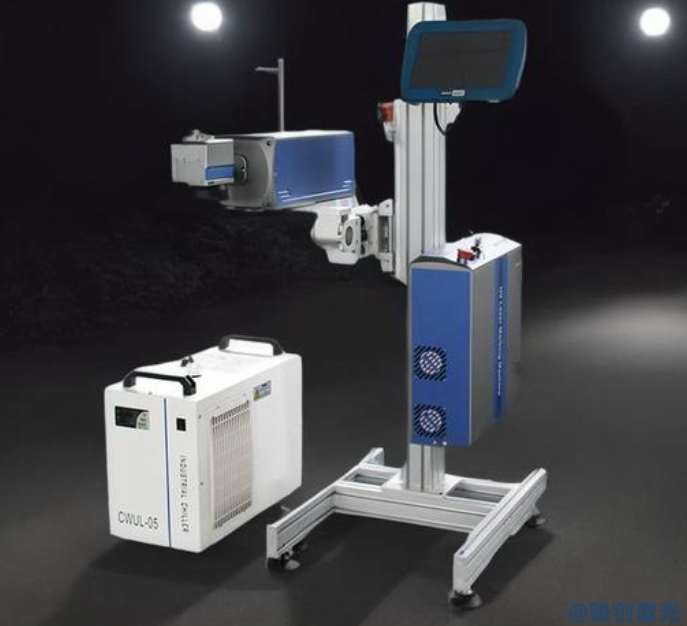When selecting a flying laser marking machine, businesses need to consider several factors to ensure the equipment meets production needs while providing optimal performance and cost-effectiveness. Below are the key factors to consider when choosing a flying laser marking machine:

1. Marking Materials
Different laser marking machines are suitable for different types of materials. Therefore, the first step in choosing a flying laser marking machine is to clarify the materials you need to mark. Common materials include:
- Metals (such as stainless steel, aluminum, iron)
- Plastics (such as PET, PVC, ABS)
- Glass
- Cardboard (such as cartons, labels)
- Wood and leather
The type of laser source (e.g., CO2 laser, fiber laser) should be selected based on the material type.
- Recommendation: Choose a laser marking machine that is suitable for your target materials.
2. Marking Speed
Marking speed is an important factor, especially in high-speed production lines. If the production line runs at high speeds, you must select a machine capable of marking at high speeds without compromising quality. Flying laser marking machines are commonly used in high-speed production environments, so consider the following:
Whether the marking speed matches the production line speed.
Whether the machine can maintain high-efficiency marking without interrupting production.
Recommendation: Choose a machine with high speed and stability to match the production line’s efficiency.
3. Marking Content and Precision
Flying laser marking machines are typically used for marking batch numbers, production dates, QR codes, barcodes, serial numbers, etc. When selecting, consider the following factors:
Marking Precision: For applications requiring fine marking, select a machine with higher precision, such as those marking small characters or QR codes.
Variable Information Support: If you need to mark dynamic or variable information (e.g., dates, batch numbers, serial numbers), the machine must support real-time data input.
Recommendation: Choose a machine with the appropriate marking precision and support for variable data input.
4. Laser Source Type
The laser source is the core component of a flying laser marking machine, and different types of lasers are suitable for different applications. Common laser sources include:
- Fiber Laser: Suitable for marking metals, hard plastics, and other materials, offering high precision and long lifespan, ideal for fine marking.
- CO2 Laser: Best for non-metal materials such as paper, plastics, wood, glass, etc., commonly used for marking packaging and plastic bottles.
- UV Laser: Suitable for delicate marking on materials such as glass, electronics, and thin films.
Select the laser source based on the material and precision requirements of your application.
- Recommendation: Choose the appropriate laser source for the materials and precision required.
5. Marking Area and Size
Flying laser marking machines can mark products of various sizes. When choosing, consider the marking area and the size of the content to be marked. If the product is large, you will need a machine with a larger marking area. If you need to mark small or complex characters, the machine should offer high-precision marking capabilities.
- Recommendation: Select a machine with an appropriate marking area and size that fits your production requirements.
6. System Integration and Compatibility
Flying laser marking machines need to be integrated with other equipment in the production line, such as conveyors and control systems. When selecting, consider:
System Compatibility: Whether the machine can seamlessly integrate with your existing production line.
Control System: Whether the machine can interface with ERP, MES, or other systems to enable real-time updates and data transmission.
Recommendation: Ensure that the machine is compatible with other equipment and control systems on your production line.
7. Equipment Stability and After-Sales Service
Since flying laser marking machines are used in continuous, high-volume production, it is essential that the equipment is stable and requires minimal maintenance. When choosing, consider:
Stability: Choosing a well-established brand typically ensures higher stability and longer lifespan.
After-Sales Service: Whether the manufacturer provides timely technical support, repair services, and training.
Recommendation: Choose a manufacturer with reliable after-sales service and technical support to ensure stable, long-term operation.
8. Cost and Budget
The price of flying laser marking machines can vary widely based on factors such as technology, configuration, and production capacity. When choosing, balance the machine's performance and cost according to your budget. For small to medium-sized businesses, a cost-effective solution may be suitable, while larger enterprises or high-end markets might prioritize higher performance and long-term reliability.
- Recommendation: Choose a machine with good cost-performance ratio based on your budget, while considering long-term operational costs (e.g., power consumption, maintenance).
Conclusion
When selecting a flying laser marking machine, businesses need to consider various factors such as marking materials, speed, precision, laser source type, marking area, system integration, equipment stability, and budget. By making an informed decision based on these factors, companies can ensure that the chosen equipment meets production needs, improves efficiency, and reduces long-term operating costs.


